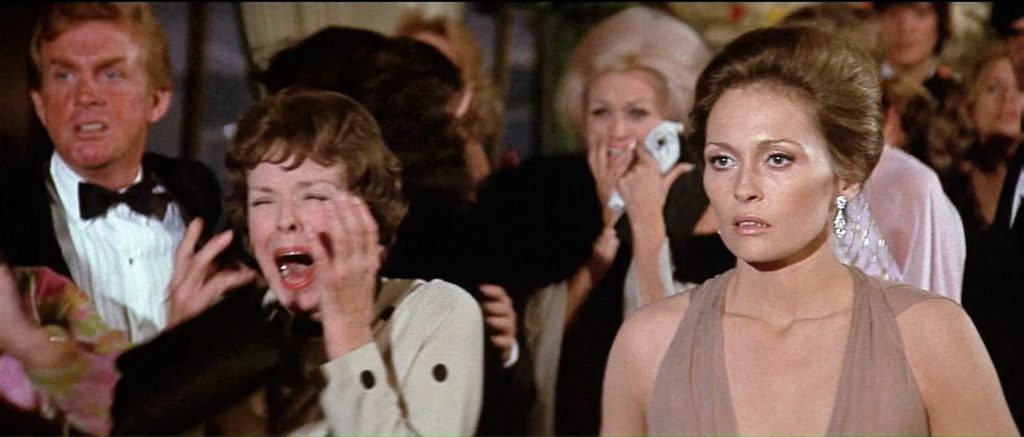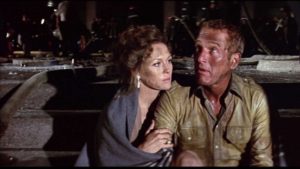Most cinephiles will get a faraway look in their eyes when they reminisce about 1970’s cinema and the way that “they don’t make them like they used to.” We rant and rave about the fact that film studios are no longer willing to take risks or target adult audiences who are ready to deal with storytelling techniques that make them do some of the work rather than sitting back and being told exactly what they are seeing. We will mostly focus on figures like John Cassavetes and pretend that mainstream audiences were totally showing up to a daytime screening of Minnie and Moskowitz (1971). I would never deny that this was a wonderful decade for American mainstream cinema as you could have blockbusters that incorporated motifs from the French New Wave and less formulaic productions that went in original directions.
At the same time, I think that we should be re-examining a lot of the mainstream trash from this decade as it tells us a lot about the cultural revolution that was sweeping the nation at the time and what was considered more traditional entertainment during a period in which debauchery and Satanic rituals were commonplace in multiplex fare. Disaster movies had always been around to some degree. Films such as San Francisco (1936) and The High and the Mighty (1954) had been wildly popular in previous decades but the genre really took off in the 1970’s. In the same way that the superhero genre is dominant today, Irwin Allen’s disaster movies were a seemingly unstoppable force in that decade. He would round up a cabal of Old Hollywood stars, spend millions of dollars on a few sets that were filled with hermetically sealed props, find an airport novel to adapt, and then spend most of his time advertising a product that wasn’t nearly as thrilling as the trailers promised it would be. These were supposed to be lavish spectacles that were full of suspense and sexy movie stars, but they also had to be three hours long and feature about thirty underdeveloped characters. He also tried to turn them into morality tales of sorts. They featured characters who were impure, by the standards of the time, and were drowned or burned alive in a freak gasoline accident while the cute old grandmother miraculously holds her breath underwater for several hours and ends up surviving. This was basic, elemental stuff and audiences had seen it all in different forms before but Allen was very good at promoting his slick, shiny packages to people who were less willing to put themselves through a dark, moody crime drama like Chinatown (1974).
The Towering Inferno (1974) was arguably his greatest success as it was the highest grossing film of 1974, earned a Best Picture nomination and united two of the biggest stars of all time. It is probably the best disaster movie that I have ever seen but I am comparing it to poorly made crap like Airport (1970) and Voyage of the Damned (1976). Both of those films included individual elements that are more electrifying than anything that can be seen in The Towering Inferno. Maureen Stapleton is wrenching as the wife of a suicide bomber in Airport and is singularly responsible for making us briefly look past the ridiculousness of that plot line. She makes us care about a throwaway character and gives the sort of performance that is worthy of a John Schlesinger character study. Voyage of the Damned benefitted from some stunning costumes that would have felt at home in the closet of Babe Paley. Sure, they were more contemporary than they should have been but it was still a treat to see Wendy Hiller swishing around in a white silk caftan. The Towering Inferno is more than the sum of its parts in many ways, even though it is still a boring, overlong mess.
The Glass Tower, a 138 story skyscraper, has been designed by architect Doug Roberts (Paul Newman) who is concerned about the fact that the specifications he had made for security reasons have been disobeyed by electrical engineer Roger Simmons (Richard Chamberlain). Simmons is the son-in-law of head builder James Duncan (William Holden) who intends to go ahead with an opening celebration, despite the potential fire hazards. Predictably, a fire does start to spread and the guests, gathered on the 81st floor, struggle to get down while employees on other floors die because they cannot contact others. Fire chief Michael O’Hallorhan (Steve McQueen) is brought in to control the fire, so he and Roberts team up to help evacuate people from the building and eventually set up water bombs that put out the blaze once and for all. Along the way a romance develops between incompetent conman Harlee Claiborne (Fred Astaire) and the woman he intends to con, Lisolette Mueller, (Jennifer Jones).
It often feels like an extended trailer, as most scenes focusing on character development feel so brief that they could easily be cut and pasted into a television spot that would convince some adolescent that Faye Dunaway was going to be in her underwear in every scene. The action set pieces go on forever without ever building up much tension and they tend to end with a supposed tragedy that makes you want to laugh, rather than weeping tears of sadness and anguish. The millions of characters who pop up are all defined by one or two character traits and the script requires them to keep reminding us of the fact that they are an adulterer with anxiety or a naive pensioner. They all have their little character arcs but they have to move mountains in the space of minutes to convince us of the fact that such dramatic, over the top situations have been resolved so quickly and neatly. We don’t care when any of them die and this means that there are absolutely no stakes.
I suspect that the response to this film at the time was driven by the advertising and expectations that the target audience had built up in their minds. When you love the concept of something you can spend time daydreaming about the perfect film that you would like to put together. When you actually see the film that has resulted from the concept that was so appealing to you, you might feel a little bit of disappointment but you can project your ideal vision onto what you are seeing and still walk away satisfied. It was easier to experience something like this back in the 1970’s as there were less major blockbusters being released each year and you couldn’t gather that much information about the film beyond what the studios were presenting to you. Now, you get several teaser trailers, read early responses on Twitter and can even access the films before they are released through illegal means. There just isn’t the same special quality and that means that it is easier to notice the fact that this film drags and isn’t all that entertaining.
It works best when the emphasis is on the glamour of some of the stars and actresses like Dunaway are allowed to exude their natural grace and elegance. She plays a character who really doesn’t need to be involved in this story and she is only there so that the producers could slap another famous name onto the poster, but she does come through. She was unbelievably beautiful in 1974 and those sharp cheekbones, chestnut brown hair, pale skin, and hazel eyes, still have the ability to stun. Her star qualities go beyond her looks, however, and she seems at home in her role in a way that other stars don’t. She plays a woman who knows that she is seen as alluring and classy and she makes an effort to appear imperious in the presence of other women. She and Newman aren’t exactly burning up the screen with their chemistry, but they showed up and did what was asked of them. Other cast members seem totally lost and don’t understand the tone of the film that they are in. McQueen plays it straight and comes across as flat and empty, Fred Astaire doesn’t even get to break out into a dance and Chamberlain’s strained grin belies the fact that he didn’t have much range. Jones is the star who really gets thrown under the bus. This was her last film role and it is saddening to see a legend being wasted when she still had so much to give. She is asked to wear a white dress, hold onto Astaire’s arm, deliver some nonsensical dialogue, and then die an unintentionally hilarious death. Hollywood has never been great at using older actresses but this film could have been fun if performers like Jones had been given something to work with. As it is, she has to say “Is it a good investment?” about three times.
The morality of the film is also questionable and the Cecil B. DeMille style fire and brimstone is rather difficult to tolerate. Two people having an affair end up burning alive in the room that they were canoodling in and Astaire’s character is punished for his past crimes when his new girlfriend, Jones, ends up dying. It all feels far too simplistic but they don’t even get their arms around the basic points they want to make. There seems to be some idea about the dangers of the excess of this era floating around in the ether but other than a few cryptic statements from Newman’s character, it is difficult to understand where the point of this story lies.
This is a loud, bombastic, dumb blockbuster and it just doesn’t thrill audiences in the same way that it would have in 1974. I really question whether it became a sensation purely as a result of hype.







